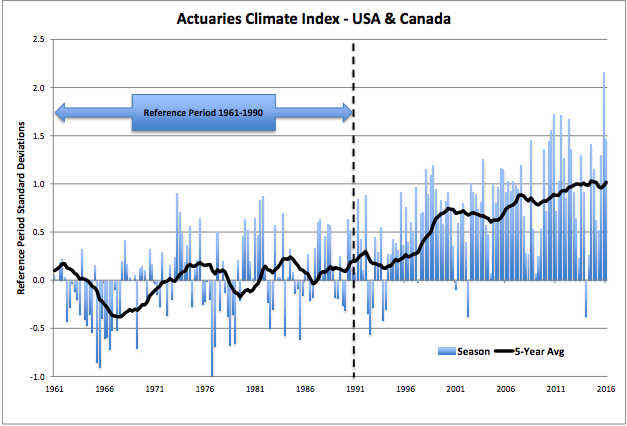Organizations representing the actuarial profession in Canada and the United States launched the Actuaries Climate Index (ACI), which has found that incidents of extreme weather have increased threefold from the reference period.
The risk measured by the ACI is relative to the average frequencies during the reference period of 1961–1990. The index value remained below 0.25 during the reference period, reached a value of 0.5 in 1998, and first reached 1.0 in 2013. These values indicate a sustained increase in the frequency of extreme weather occurrences and changes in sea levels. The current five-year average is 1.02.
Higher index values indicate an increase in the occurrence of extreme weather events. The ACI values support an understanding that the impacts of extreme weather events, such as high temperature, heavy precipitation, and drought are increasing.
David Dickson, president of the Canadian Institute of Actuaries said, “The [actuarial] profession wanted to demonstrate that actuaries and climate scientists could combine their education and training to come up with a tool that could be of use to governments, environmental groups, and scientists. I am convinced that we succeeded, and we will be working with our partners to add even more value to the index.”
The Actuaries Climate Index was developed by the Climate Change Committee, which is a joint effort of the American Academy of Actuaries, the Canadian Institute of Actuaries, the Casualty Actuarial Society, and the Society of Actuaries.
“The Actuaries Climate Index is designed to provide objective data about changes in the frequency of extreme climate events over recent decades in Canada and the continental United States,” said Doug Collins, Chair of the Climate Change Committee. “Actuaries are experienced in the assessment and mitigation of the financial consequences of risk, and we have developed the index for analyzing the climate.”
The current highest five-year average values by region are in the Northwest Pacific (British Columbia and Yukon Territory), Northeast Atlantic (New Brunswick, Newfoundland and Labrador, Nova Scotia, Prince Edward Island) and Southern Plains (Kansas, Montana, North Dakota, Nebraska, Oklahoma, South Dakota, Texas, and Wyoming).
Updates for values will be posted quarterly on ActuariesClimateIndex.org as data for each meteorological season becomes available. The organizations are also developing a second index, the Actuaries Climate Risk Index (ACRI), which will measure correlations between changes in the frequency of extreme events as measured by the index and economic losses, mortality, and injuries.













